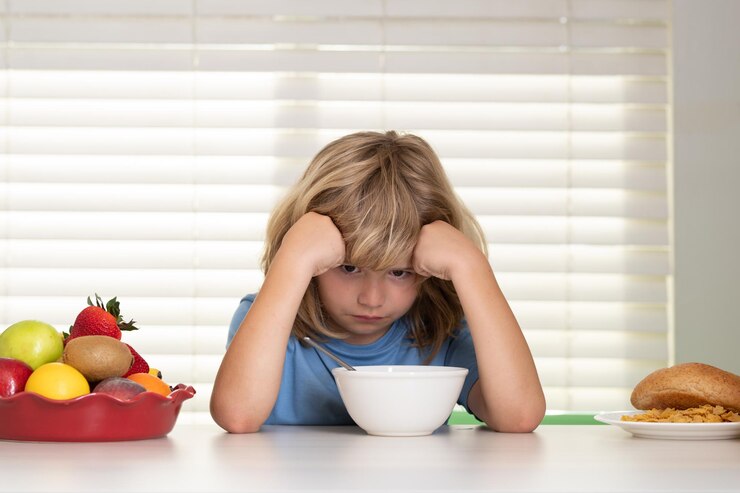Breaking the Silence: Understanding and Addressing Eating Disorders in Children
Breaking the Silence: Gain insights on childhood eating disorders, fostering understanding and effective intervention. Eating Disorders in Children.
 In today’s society, where body image and societal pressures are pervasive, it’s becoming increasingly important to shed light on a topic that often goes unnoticed: eating disorders in children. These disorders, which include anorexia nervosa, bulimia nervosa, and binge eating disorder, can have devastating consequences on a child’s physical and emotional well-being. However, the first step towards addressing this issue is understanding it. Why do children develop eating disorders? What signs should parents and caregivers be aware of? And most importantly, how can we effectively intervene and provide support? In this article, we will delve deep into the world of eating disorders in children, exploring the underlying factors, the warning signs to watch out for, and the most effective treatment approaches. By breaking the silence surrounding this topic, we aim to empower parents, educators, and healthcare providers with the knowledge and tools needed to address eating disorders in children, ultimately fostering a healthier and more compassionate society. Join us as we unravel the complexity of eating disorders in children and work towards creating a world where every child can grow up happy, healthy, and free from the burden of these silent struggles.
In today’s society, where body image and societal pressures are pervasive, it’s becoming increasingly important to shed light on a topic that often goes unnoticed: eating disorders in children. These disorders, which include anorexia nervosa, bulimia nervosa, and binge eating disorder, can have devastating consequences on a child’s physical and emotional well-being. However, the first step towards addressing this issue is understanding it. Why do children develop eating disorders? What signs should parents and caregivers be aware of? And most importantly, how can we effectively intervene and provide support? In this article, we will delve deep into the world of eating disorders in children, exploring the underlying factors, the warning signs to watch out for, and the most effective treatment approaches. By breaking the silence surrounding this topic, we aim to empower parents, educators, and healthcare providers with the knowledge and tools needed to address eating disorders in children, ultimately fostering a healthier and more compassionate society. Join us as we unravel the complexity of eating disorders in children and work towards creating a world where every child can grow up happy, healthy, and free from the burden of these silent struggles.
Common Types of Eating Disorders in Children
Eating disorders in children can manifest in various forms, each presenting its own set of challenges and symptoms.
- Anorexia Nervosa: Characterized by an extreme fear of gaining weight and a distorted body image, children with anorexia may restrict their food intake severely, leading to significant weight loss and malnutrition.
- Bulimia Nervosa: Children with bulimia engage in episodes of binge eating followed by purging behaviors such as vomiting or excessive exercise. This cycle of binging and purging can have serious consequences on both physical and mental health.
- Binge Eating Disorder: Children with binge eating disorder consume large quantities of food in a short period, often feeling a lack of control over their eating habits. Unlike bulimia, they do not engage in purging behaviors afterward.
Signs and Symptoms of Eating Disorders in Children
 Recognizing the signs and symptoms of eating disorders in children is crucial for early intervention and support.
Recognizing the signs and symptoms of eating disorders in children is crucial for early intervention and support.
- Physical Signs: Rapid weight loss or fluctuations, fatigue, dizziness, fainting, stomach complaints, and changes in eating habits or food rituals.
- Emotional and Behavioral Signs: Obsessive thoughts about food, body dissatisfaction, social withdrawal, irritability, secrecy around eating habits, and low self-esteem.
- Cognitive Signs: Preoccupation with body image, distorted perception of body size or shape, and perfectionism.
Causes and Risk Factors of Eating Disorders in Children
Several factors contribute to the development of eating disorders in children, including genetic, environmental, psychological, and societal influences.
- Genetic Predisposition: Children with a family history of eating disorders may be at higher risk of developing one themselves.
- Environmental Factors: Cultural ideals of thinness, peer pressure, media influence, trauma, and stressful life events can all contribute to the development of eating disorders in children.
- Psychological Factors: Low self-esteem, perfectionism, anxiety, depression, and difficulty coping with emotions can increase the vulnerability to eating disorders.
The Impact of Eating Disorders on Children’s Physical and Mental Health
 Eating disorders can have profound effects on children’s physical and mental well-being, often leading to serious medical complications and psychological distress.
Eating disorders can have profound effects on children’s physical and mental well-being, often leading to serious medical complications and psychological distress.
- Physical Health Consequences: Malnutrition, electrolyte imbalances, dehydration, gastrointestinal problems, cardiovascular issues, and stunted growth and development.
- Mental Health Effects: Anxiety, depression, obsessive-compulsive behaviors, self-harm, substance abuse, and suicidal thoughts or behaviors.
How to Talk to Your Child About Eating Disorders
Approaching the topic of eating disorders with sensitivity and empathy is essential for fostering open communication and support.
- Create a Safe Environment: Choose a time and place where your child feels comfortable and supported.
- Express Concern: Approach the conversation with empathy and express your concerns about their well-being.
- Listen Without Judgment: Allow your child to express their feelings and experiences without fear of judgment or criticism.
- Offer Support: Let your child know that you are there to support them and help them get the help they need.
Seeking Professional Help for Children with Eating Disorders
Seeking professional help is crucial for the effective treatment and recovery of children with eating disorders.
- Medical Evaluation: Consult with a healthcare professional to assess your child’s physical and mental health and determine the appropriate course of treatment.
- Therapy: Cognitive-behavioral therapy (CBT), family therapy, and nutritional counseling are often recommended for children with eating disorders.
- Medication: In some cases, medication may be prescribed to address co-occurring mental health conditions such as depression or anxiety.
Treatment Options for Children with Eating Disorders
Treatment for eating disorders in children typically involves a multidisciplinary approach tailored to the individual needs of the child.
- Nutritional Rehabilitation: Working with a registered dietitian to restore healthy eating habits and address nutritional deficiencies.
- Therapeutic Interventions: Engaging in therapy to address underlying psychological factors and develop coping skills to manage emotions and behaviors.
- Family Involvement: Involving the family in treatment can provide crucial support and help address familial dynamics that may contribute to the eating disorder.
Support and Resources for Parents of Children with Eating Disorders
Parents of children with eating disorders often need support and guidance to navigate the challenges of recovery.
- Support Groups: Joining a support group for parents of children with eating disorders can provide a sense of community and understanding.
- Educational Resources: Educate yourself about eating disorders and treatment options to better support your child’s recovery journey.
- Self-Care: Taking care of your own physical and emotional well-being is essential for effectively supporting your child through their recovery.
 Conclusion: Promoting a Healthy Relationship with Food and Body Image in Children
Conclusion: Promoting a Healthy Relationship with Food and Body Image in Children
In conclusion, addressing eating disorders in children requires a comprehensive understanding of the underlying factors, early recognition of warning signs, and access to appropriate treatment and support. By breaking the silence surrounding this issue and fostering open communication, we can empower parents, educators, and healthcare providers to intervene effectively and promote a healthier relationship with food and body image in children. Together, let’s work towards creating a world where every child can grow up happy, healthy, and free from the burden of these silent struggles.
Learn more about Eating Disorders in Children on our YouTube channel.
#parentsofchildrenwitheatingdisorders #eatingdisordersandtreatmentoptions #addressingeatingdisordersinchildren #childrenwitheatingdisorders




